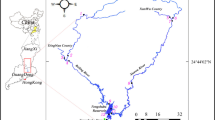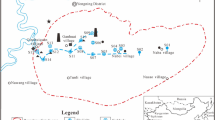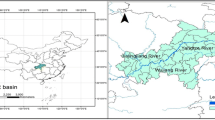Abstract
The resource, environment, and ecological value of drinking reservoirs have received widespread concerns due to the pollution of persistent organic pollutants such as polycyclic aromatic hydrocarbons (PAHs). Therefore, we comprehensively studied the occurrence, source, distribution, and risk assessment of representative PAHs in Fengshuba Reservoir (FSBR) (large drinking reservoir, China). The total concentrations of 16 USEPA PAHs in the water phase, porewater phase, sediment phase, and soil phase were in ranges of 109.72–393.19 ng/L, 5.75–35.15 μg/L, 364.4–743.71 μg/kg, and 367.81–639.89 μg/kg, respectively. The naphthalene (Nap) was the dominant PAHs in the water phase, while it was Nap and phenanthrene (Phe) in porewater, sediment, and soil phase. The main sources of PAHs in FSBR were biomass combustion. Redundancy analysis indicated that the NTU, NO2-, NH4+, Chl-α, and IC were the dominant factors influencing the PAH distribution in water phase, and the PAHs in sediment phase was affected by T and NO3-. Pseudo-partitioning coefficients indicated that the PAHs in the porewater phase were more likely to migrate to the sediment phase. Risk assessment indicated that the PAHs both in the water and sediment phases were generally in a low-risk state, while the PAHs in the soil phase were in a moderate-risk state, and the Nap was in a high-risk state, and exposure to the PAHs in FSBR through drinking and skin exposure had little impact on consumers’ health. In summary, Nap could be used as a key indicator to evaluate the existence and potential risk of PAHs in FSBR.







Similar content being viewed by others
Data Availability
1. The datasets generated during and/or analyzed during the current study are available from the corresponding author on reasonable request.
2. All data generated or analyzed during this study are included in this published article (and its supplementary information files).
References
Akhbarizadeh R, Moore F, Keshavarzi B, Moeinpour A (2016) Aliphatic and polycyclic aromatic hydrocarbons risk assessment in coastal water and sediments of Khark Island, SW Iran. Mar Pollut Bull 108(1-2):33–45. https://doi.org/10.1016/j.marpolbul.2016.05.004
Ambade B, Sethi SS (2021) Health Risk Assessment and Characterization of Polycyclic Aromatic Hydrocarbon from the Hydrosphere. J Hazard Toxic Radioact Waste 25(2):05020008. https://doi.org/10.1061/(ASCE)HZ.2153-5515.0000586
Araghi PE, Bastami KD, Rahmanpoor S (2014) Distribution and sources of polycyclic aromatic hydrocarbons in the surface sediments of Gorgan Bay, Caspian Sea. Mar Pollut Bull 89(1-2):494–498. https://doi.org/10.1016/j.marpolbul.2013.12.001
Bai Y, Meng W, Xu J, Zhang Y, Guo C, Lv J, Wan J (2014) Occurrence, distribution, environmental risk assessment and source apportionment of polycyclic aromatic hydrocarbons (PAHs) in water and sediments of the Liaohe River Basin, China. Bull Environ Contam Toxicol 93(6):744–751. https://doi.org/10.1007/s00128-014-1390-7
Bianco F, Race M, Papirio S, Esposito G (2020) Removal of polycyclic aromatic hydrocarbons during anaerobic biostimulation of marine sediments. Sci Total Environ 709:136141. https://doi.org/10.1016/j.scitotenv.2019.136141
Bigus P, Tobiszewski M, Namiesnik J (2014) Historical records of organic pollutants in sediment cores. Mar Pollut Bull 78(1-2):26–42. https://doi.org/10.1016/j.marpolbul.2013.11.008
Budzinski H, Jones I, Bellocq J, Piérard C, Garrigues P (1997) Evaluation of sediment contamination by polycyclic aromatic hydrocarbons in the Gironde estuary. Mar Chem 58(1):85–97. https://doi.org/10.1016/S0304-4203(97)00028-5
Cao H, Chao S, Qiao L, Jiang Y, Zeng X, Fan X (2017) Urbanization-related changes in soil PAHs and potential health risks of emission sources in a township in Southern Jiangsu, China. Sci Total Environ 575:692–700. https://doi.org/10.1016/j.scitotenv.2016.09.106
Cao Z, Liu J, Luan Y, Li Y, Ma M, Xu J, Han S (2010) Distribution and ecosystem risk assessment of polycyclic aromatic hydrocarbons in the Luan River, China. Ecotoxicology 19(5):827–837. https://doi.org/10.1007/s10646-010-0464-5
Chen Y, Cui K, Huang Q, Guo Z, Huang Y, Yu K, He Y (2020) Comprehensive insights into the occurrence, distribution, risk assessment and indicator screening of antibiotics in a large drinking reservoir system. Sci Total Environ 716:137060. https://doi.org/10.1016/j.scitotenv.2020.137060
Chen Y, Li P, Huang Y, Yu K, Chen H, Cui K, Huang Q, Zhang J, Yew-Hoong Gin K, He Y (2019) Environmental media exert a bottleneck in driving the dynamics of antibiotic resistance genes in modern aquatic environment. Water Res 162:127–138. https://doi.org/10.1016/j.watres.2019.06.047
Chen Y, Yu K, Zhou Y, Ren L, Kirumba G, Zhang B, He Y (2017) Characterizing spatiotemporal variations of chromophoric dissolved organic matter in headwater catchment of a key drinking water source in China. Environ Sci Pollut Res Int 24(36):27799–27812. https://doi.org/10.1007/s11356-017-0307-5
Dat ND, Chang MB (2017) Review on characteristics of PAHs in atmosphere, anthropogenic sources and control technologies. Sci Total Environ 609:682–693. https://doi.org/10.1016/j.scitotenv.2017.07.204
De La Torre-Roche RJ, Lee WY, Campos-Diaz SI (2009) Soil-borne polycyclic aromatic hydrocarbons in El Paso, Texas: analysis of a potential problem in the United States/Mexico border region. J Hazard Mater 163(2-3):946–958. https://doi.org/10.1016/j.jhazmat.2008.07.089
Ding J, Jiang Y, Liu Q, Hou Z, Liao J, Fu L, Peng Q (2016) Influences of the land use pattern on water quality in low-order streams of the Dongjiang River basin, China: A multi-scale analysis. Sci Total Environ 551-552:205–216. https://doi.org/10.1016/j.scitotenv.2016.01.162
Doong RA, Lin YT (2004) Characterization and distribution of polycyclic aromatic hydrocarbon contaminations in surface sediment and water from Gao-ping River, Taiwan. Water Res 38(7):1733–1744. https://doi.org/10.1016/j.watres.2003.12.042
Ekpo BO, Oyo-Ita OE, Oros DR, Simoneit BR (2012) Distributions and sources of polycyclic aromatic hydrocarbons in surface sediments from the Cross River estuary, S.E. Niger Delta, Nigeria. Environ Monit Assess 184(2):1037–1047. https://doi.org/10.1007/s10661-011-2019-5
El-Saeid MH, Al-Turki AM, Nadeem ME, Hassanin AS, Al-Wabel MI (2015) Photolysis degradation of polyaromatic hydrocarbons (PAHs) on surface sandy soil. Environ Sci Pollut Res Int 22(13):9603–9616. https://doi.org/10.1007/s11356-015-4082-x
Eremina N, Paschke A, Mazlova EA, Schuurmann G (2016) Distribution of polychlorinated biphenyls, phthalic acid esters, polycyclic aromatic hydrocarbons and organochlorine substances in the Moscow River, Russia. Environ Pollut 210:409–418. https://doi.org/10.1016/j.envpol.2015.11.034
Guo J, Chen J, Wang J (2017) Sedimentary records of polycyclic aromatic hydrocarbons in China: A comparison to the worldwide. Crit Rev Environ Sci Technol 47(17):1612–1667. https://doi.org/10.1080/10643389.2017.1393262
Han B, Liu A, He S, Li Q, Zheng L (2020) Composition, content, source, and risk assessment of PAHs in intertidal sediment in Shilaoren Bay, Qingdao, China. Mar Pollut Bull 159:111499. https://doi.org/10.1016/j.marpolbul.2020.111499
Han J, Liang Y, Zhao B, Wang Y, Xing F, Qin L (2019) Polycyclic aromatic hydrocarbon (PAHs) geographical distribution in China and their source, risk assessment analysis. Environ Pollut 251:312–327. https://doi.org/10.1016/j.envpol.2019.05.022
Hartmann PC, Quinn JG, Cairns RW, King JW (2004) The distribution and sources of polycyclic aromatic hydrocarbons in Narragansett Bay surface sediments. Mar Pollut Bull 48(3-4):351–358. https://doi.org/10.1016/j.marpolbul.2003.08.014
He Y, Lin K, Chen X (2013) Effect of Land Use and Climate Change on Runoff in the Dongjiang Basin of South China. Math Probl Eng 2013:1–14. https://doi.org/10.1155/2013/471429
He Y, Yang C, He W, Xu F (2020) Nationwide health risk assessment of juvenile exposure to polycyclic aromatic hydrocarbons (PAHs) in the water body of Chinese lakes. Sci Total Environ 723:138099. https://doi.org/10.1016/j.scitotenv.2020.138099
Hussain I, Syed JH, Kamal A, Iqbal M, Eqani SA, Bong CW, Taqi MM, Reichenauer TG, Zhang G, Malik RN (2016) The relative abundance and seasonal distribution correspond with the sources of polycyclic aromatic hydrocarbons (PAHs) in the surface sediments of Chenab River, Pakistan. Environ Monit Assess 188(6):378. https://doi.org/10.1007/s10661-016-5359-3
Idowu O, Semple KT, Ramadass K, O'Connor W, Hansbro P, Thavamani P (2019) Beyond the obvious: Environmental health implications of polar polycyclic aromatic hydrocarbons. Environ Int 123:543–557. https://doi.org/10.1016/j.envint.2018.12.051
Jiao W, Lu Y, Wang T, Li J, Han J, Wang G, Hu W (2009) Polycyclic aromatic hydrocarbons in soils around Guanting Reservoir, Beijing, China. Chem Ecol 25(1):39–48. https://doi.org/10.1080/02757540802657193
Keith L, Telliard W (1979) ES&T Special Report: Priority pollutants: I-a perspective view. Environ Sci Technol 13(4):416–423. https://doi.org/10.1021/es60152a601
Kim KH, Jahan SA, Kabir E, Brown RJ (2013) A review of airborne polycyclic aromatic hydrocarbons (PAHs) and their human health effects. Environ Int 60:71–80. https://doi.org/10.1016/j.envint.2013.07.019
Li C, Huo S, Yu Z, Xi B, Yeager KM, He Z, Ma C, Zhang J, Wu F (2017) National investigation of semi-volatile organic compounds (PAHs, OCPs, and PCBs) in lake sediments of China: Occurrence, spatial variation and risk assessment. Sci Total Environ 579:325–336. https://doi.org/10.1016/j.scitotenv.2016.11.097
Li R, Hua P, Zhang J, Krebs P (2020) Effect of anthropogenic activities on the occurrence of polycyclic aromatic hydrocarbons in aquatic suspended particulate matter: Evidence from Rhine and Elbe Rivers. Water Res 179:115901. https://doi.org/10.1016/j.watres.2020.115901
Li Y, Liu J, Cao Z, Lin C, Yang Z (2010) Spatial distribution and health risk of heavy metals and polycyclic aromatic hydrocarbons (PAHs) in the water of the Luanhe River Basin, China. Environ Monit Assess 163(1-4):1–13. https://doi.org/10.1007/s10661-009-0811-2
Lu J, Zhang C, Wu J, Lin Y, Zhang Y, Yu X, Zhang Z (2019) Pollution, sources, and ecological-health risks of polycyclic aromatic hydrocarbons in coastal waters along coastline of China. Hum Ecol Risk Assess Int J 26(4):968–985. https://doi.org/10.1080/10807039.2018.1548899
Maskaoui K, Zhou JL, Hong HS, Zhang ZL (2002) Contamination by polycyclic aromatic hydrocarbons in the Jiulong River Estuary and Western Xiamen Sea, China. Environ Pollut 118(1):109–122. https://doi.org/10.1016/S0269-7491(01)00208-1
Meng Y, Liu X, Lu S, Zhang T, Jin B, Wang Q, Tang Z, Liu Y, Guo X, Zhou J, Xi B (2019) A review on occurrence and risk of polycyclic aromatic hydrocarbons (PAHs) in lakes of China. Sci Total Environ 651(Pt 2):2497–2506. https://doi.org/10.1016/j.scitotenv.2018.10.162
Mojiri A, Zhou JL, Ohashi A, Ozaki N, Kindaichi T (2019) Comprehensive review of polycyclic aromatic hydrocarbons in water sources, their effects and treatments. Sci Total Environ 696:133971. https://doi.org/10.1016/j.scitotenv.2019.133971
Nadal M, Schuhmacher M, Domingo JL (2004) Levels of PAHs in soil and vegetation samples from Tarragona County, Spain. Environ Pollut 132(1):1–11. https://doi.org/10.1016/j.envpol.2004.04.003
Nascimento RA, de Almeida M, Escobar NCF, Ferreira SLC, Mortatti J, Queiroz AFS (2017) Sources and distribution of polycyclic aromatic hydrocarbons (PAHs) and organic matter in surface sediments of an estuary under petroleum activity influence, Todos os Santos Bay, Brazil. Mar Pollut Bull 119(2):223–230. https://doi.org/10.1016/j.marpolbul.2017.03.069
Niu L, van Gelder P (2020) Distribution and source assessment of polycyclic aromatic hydrocarbons levels from Lake IJssel (the Netherlands) and their responses to hydrology. Water Environ Res 92(8):1214–1229. https://doi.org/10.1002/wer.1317
Opere WM, John M, Ombori O (2020) Occurrence of Enteric Viruses in Surface Water and the Relationship with Changes in Season and Physical Water Quality Dynamics. Adv Virol 2020:9062041–9062011. https://doi.org/10.1155/2020/9062041
Palm A, Cousins I, Gustafsson O, Axelman J, Grunder K, Broman D, Brorstrom-Lunden E (2004) Evaluation of sequentially-coupled POP fluxes estimated from simultaneous measurements in multiple compartments of an air-water-sediment system. Environ Pollut 128(1-2):85–97. https://doi.org/10.1016/j.envpol.2003.08.023
Patrolecco L, Ademollo N, Capri S, Pagnotta R, Polesello S (2010) Occurrence of priority hazardous PAHs in water, suspended particulate matter, sediment and common eels (Anguilla anguilla) in the urban stretch of the River Tiber (Italy). Chemosphere 81(11):1386–1392. https://doi.org/10.1016/j.chemosphere.2010.09.027
Pies C, Hoffmann B, Petrowsky J, Yang Y, Ternes TA, Hofmann T (2008) Characterization and source identification of polycyclic aromatic hydrocarbons (PAHs) in river bank soils. Chemosphere 72(10):1594–1601. https://doi.org/10.1016/j.chemosphere.2008.04.021
Qiao M, Wang C, Huang S, Wang D, Wang Z (2006) Composition, sources, and potential toxicological significance of PAHs in the surface sediments of the Meiliang Bay, Taihu Lake, China. Environ Int 32(1):28–33. https://doi.org/10.1016/j.envint.2005.04.005
Saeedi M, Li LY, Salmanzadeh M (2012) Heavy metals and polycyclic aromatic hydrocarbons: pollution and ecological risk assessment in street dust of Tehran. J Hazard Mater 227-228:9–17. https://doi.org/10.1016/j.jhazmat.2012.04.047
Sanches S, Leitao C, Penetra A, Cardoso VV, Ferreira E, Benoliel MJ, Crespo MT, Pereira VJ (2011) Direct photolysis of polycyclic aromatic hydrocarbons in drinking water sources. J Hazard Mater 192(3):1458–1465. https://doi.org/10.1016/j.jhazmat.2011.06.065
Sarria-Villa R, Ocampo-Duque W, Paez M, Schuhmacher M (2016) Presence of PAHs in water and sediments of the Colombian Cauca River during heavy rain episodes, and implications for risk assessment. Sci Total Environ 540:455–465. https://doi.org/10.1016/j.scitotenv.2015.07.020
Seopela MP, McCrindle RI, Combrinck S, Augustyn W (2020) Occurrence, distribution, spatio-temporal variability and source identification of n-alkanes and polycyclic aromatic hydrocarbons in water and sediment from Loskop dam, South Africa. Water Res 186:116350. https://doi.org/10.1016/j.watres.2020.116350
Shen B, Wu J, Zhan S, Jin M (2021) Residues of organochlorine pesticides (OCPs) and polycyclic aromatic hydrocarbons (PAHs) in waters of the Ili-Balkhash Basin, arid Central Asia: Concentrations and risk assessment. Chemosphere 273:129705. https://doi.org/10.1016/j.chemosphere.2021.129705
Sun C, Zhang J, Ma Q, Chen Y (2015) Human Health and Ecological Risk Assessment of 16 Polycyclic Aromatic Hydrocarbons in Drinking Source Water from a Large Mixed-Use Reservoir. Int J Environ Res Public Health 12(11):13956–13969. https://doi.org/10.3390/ijerph121113956
Sun JH, Wang GL, Chai Y, Zhang G, Li J, Feng J (2009) Distribution of polycyclic aromatic hydrocarbons (PAHs) in Henan Reach of the Yellow River, Middle China. Ecotoxicol Environ Saf 72(5):1614–1624. https://doi.org/10.1016/j.ecoenv.2008.05.010
Takane Y, Hwang H (2005) On a test of dimensionality in redundancy analysis. Psychometrika 70(2):271–281. https://doi.org/10.1007/s11336-003-1089-x
Tobiszewski M, Namiesnik J (2012) PAH diagnostic ratios for the identification of pollution emission sources. Environ Pollut 162:110–119. https://doi.org/10.1016/j.envpol.2011.10.025
Yim UH, Hong SH, Shim WJ (2007) Distribution and characteristics of PAHs in sediments from the marine environment of Korea. Chemosphere 68(1):85–92. https://doi.org/10.1016/j.chemosphere.2006.12.032
Yu H, Liu Y, Han C, Fang H, Weng J, Shu X, Pan Y, Ma L (2021) Polycyclic aromatic hydrocarbons in surface waters from the seven main river basins of China: Spatial distribution, source apportionment, and potential risk assessment. Sci Total Environ 752:141764. https://doi.org/10.1016/j.scitotenv.2020.141764
Yu Y, Xu J, Wang P, Sun H, Dai S (2009) Sediment-porewater partition of polycyclic aromatic hydrocarbons (PAHs) from Lanzhou Reach of Yellow River, China. J Hazard Mater 165(1-3):494–500. https://doi.org/10.1016/j.jhazmat.2008.10.042
Yuan K, Wang X, Lin L, Zou S, Li Y, Yang Q, Luan T (2015) Characterizing the parent and alkyl polycyclic aromatic hydrocarbons in the Pearl River Estuary, Daya Bay and northern South China Sea: influence of riverine input. Environ Pollut 199:66–72. https://doi.org/10.1016/j.envpol.2015.01.017
Yunker MB, Macdonald RW, Vingarzan R, Mitchell RH, Goyette D, Sylvestre S (2002) PAHs in the Fraser River basin: a critical appraisal of PAH ratios as indicators of PAH source and composition. Org Geochem 33(4):489–515. https://doi.org/10.1016/S0146-6380(02)00002-5
Zhang HB, Luo YM, Wong MH, Zhao QG, Zhang GL (2006) Distributions and concentrations of PAHs in Hong Kong soils. Environ Pollut 141(1):107–114. https://doi.org/10.1016/j.envpol.2005.08.031
Zhang J, Liu G, Wang R, Huang H (2017) Polycyclic aromatic hydrocarbons in the water-SPM-sediment system from the middle reaches of Huai River, China: Distribution, partitioning, origin tracing and ecological risk assessment. Environ Pollut 230:61–71. https://doi.org/10.1016/j.envpol.2017.06.012
Zhang Y, Lu Y, Xu J, Yu T, Zhao W (2011) Spatial distribution of polycyclic aromatic hydrocarbons from Lake Taihu, China. Bull Environ Contam Toxicol 87(1):80–85. https://doi.org/10.1007/s00128-011-0292-1
Zhao SM, Wang B, Wang DW, Li XM, Huang B, Hu P, Zhang LW, Pan XJ (2014) Environmental Behavior of PAHs in Dianchi Lake Distributions, Sources and Risk Assessment of Polycyclic Aromatic Hydrocarbons in Surface Sediments from Dianchi Lake,China. Int J Environ Res 8(2):317–328. https://doi.org/10.22059/IJER.2014.722
Zheng T, Ran Y, Chen L (2013) Polycyclic aromatic hydrocarbons (PAHs) in rural soils of Dongjiang River Basin: occurrence, source apportionment, and potential human health risk. J Soils Sediments 14(1):110–120. https://doi.org/10.1007/s11368-013-0753-8
Acknowledgements
The authors are grateful for the financial support from the National Natural Science Foundation of China (Grant No. 42007330), National Science and Technology Major Projects of Water Pollution Control and Management of China (Grant No. 2014ZX07206001), and the Fundamental Research Funds for the Central Universities (JZ2020HGQA0193).
Funding
1. National Natural Science Foundation of China (Grant No. 42007330)
2. National Science and Technology Major Projects of Water Pollution Control and Management of China (Grant No. 2014ZX07206001).
Author information
Authors and Affiliations
Contributions
Yiliang He and Kangping Cui conceived of the presented idea. Material preparation, data collection, and analysis were performed by Yihan Chen. The first draft of the manuscript was written by Xiangyang Xu. Xing Chen, Zhi Guo, Hongjie Chen, and Guangwei Deng commented on previous versions of the manuscript. All authors read and approved the final manuscript.
Corresponding authors
Ethics declarations
Ethics approval and consent to participate
Not applicable.
Consent for publication
Not applicable.
Conflict of interest
The authors declare no conflicts of interest.
Additional information
Responsible Editor: Hongwen Sun
Publisher’s note
Springer Nature remains neutral with regard to jurisdictional claims in published maps and institutional affiliations.
Supplementary Information
ESM 1
(DOCX 1410 kb)
Rights and permissions
About this article
Cite this article
Xu, ., Cui, K., Chen, Y. et al. Comprehensive insights into the occurrence, source, distribution and risk assessment of polycyclic aromatic hydrocarbons in a large drinking reservoir system. Environ Sci Pollut Res 29, 6449–6462 (2022). https://doi.org/10.1007/s11356-021-16142-0
Received:
Accepted:
Published:
Issue Date:
DOI: https://doi.org/10.1007/s11356-021-16142-0




